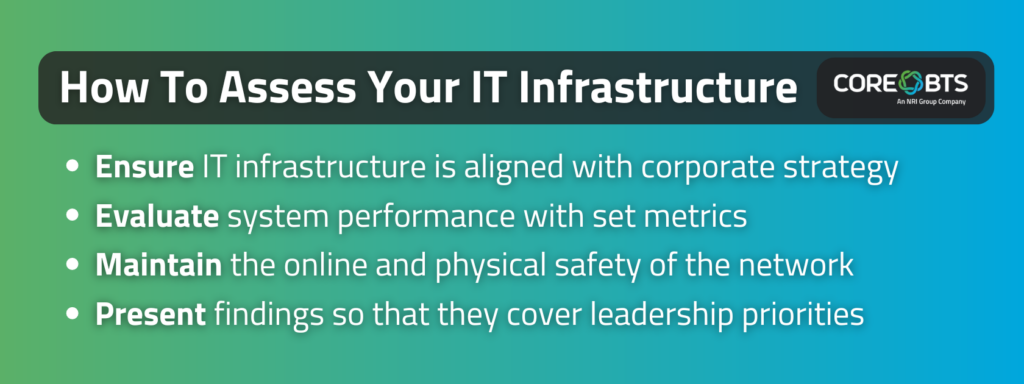Take these steps to ensure that your IT infrastructure meets the expectations of your board or leadership team

Regular assessments are necessary to ensure that your IT infrastructure is operating at peak efficiency and aligned with business objectives.
When you evaluate your IT infrastructure, you must consider meeting the expectations of your board or leadership team.
Without regularly examining how things are working, you run the risk of getting mired in IT problems, such as:
- Licensed and supported applications that are no longer needed
- Old, inefficient infrastructure that can cost you time and money
- A disconnect between IT and the business objectives designed to guide it
Read on to find out how to meet leadership expectations effectively, covering key IT infrastructure areas that include performance, security, cost-effectiveness, scalability, and alignment with business goals.
Evaluating Performance
You should begin the performance assessment by testing the infrastructure for operational efficiency, including the system’s reliability, speed, and capacity. With this information, the IT team can recommend to the board or leadership how to optimize the system’s performance properly.
The IT performance evaluation should include specific goals (perhaps reducing IT costs) and metrics for measuring them. You need to define the scope of the review, collect relevant data, interpret the results with your metrics, and then make recommendations to your leadership based on the results.
Ensuring Security
With the rise of sophisticated cybercrime, it is extremely important to evaluate security measures to protect against data breaches and ensure compliance with regulations. Infrastructure security should protect critical systems and technology assets from physical and cyber threats. These threats may range from malware and ransomware attacks to damage caused by flooding and fires.
The four different levels of IT infrastructure security include:
- Data—increasingly put at risk as it is stored in more locations and connected to more devices.
- Applications—when out of date, they are more vulnerable to attacks.
- Network—ensuring, for example, that outbound and inbound traffic conforms to set security protocols
- Physical—including offsite data recovery backups in case of a physical emergency.
Analyzing Cost-Effectiveness
Besides efficiency and security, cost is a major concern for organizational leadership. To evaluate your I.T. infrastructure from a financial perspective, it’s important to consider maintenance, upgrades, and overall operational efficiency expenses.
A cost-benefit analysis analyzes the benefits and costs of potential IT infrastructure investment, quantifying its financial impacts and how the results would align with a company’s business strategy. By identifying potential cost savings, it can help increase a return on investment (ROI). It can also streamline your processes, including improved automation, and help with risk mitigation (perhaps assessing the losses involved with keeping an outdated system).
Assessing Scalability
A scalability assessment ensures that your IT infrastructure can support business growth and adapt to changing needs without causing major disruptions to your operations. Are the scalability plans aligned with business growth goals, such as customer satisfaction, revenue growth, or cost savings?
The scalability plans might include redundant systems to ensure continuous business operations and “high availability” of critical systems so downtime is minimized and system operations run smoothly.
You should set specific scalability goals and establish metrics to measure performance. For example, are you interested in response times, throughput, availability, error rates, or something else?
Aligning with Business Goals
Here, you ensure that IT infrastructure supports strategic objectives and enhances overall business performance. This critical assessment helps the leadership understand how they can leverage their IT assets to achieve specific targets.
The IT team needs to take the set business goals and then assess their system as far as capabilities and limitations. Comparing the analysis to the goals should reveal any gaps in the infrastructure. The team should also examine the goals in an IT context to ensure they are SMART (specific, measurable, achievable, relevant, and time-bound).
Presenting Findings
When presenting their findings, the IT team should ensure the information conforms to the priorities. Most companies understand that IT is more than a practical function; it gives them a competitive advantage that can help them survive and thrive in a competitive market.
So, the leadership will want to know how the current IT setup aligns with its business strategy and what gaps need to be filled. They will also want a budget for planned changes and an ROI assessment.
The findings should also be presented in terms of current market and industry trends to demonstrate their relevance in the bigger picture.
The presentation should provide the leadership with clear, actionable insights and recommendations.
Setting Future Directions
Leadership can use assessment to guide future investments and strategic IT initiatives. Of course, these investments and initiatives are unique to each business. These initiatives may involve increasing automation and system integration, modernizing the infrastructure, or enhancing data center facilities to retain a competitive edge. Additionally, leveraging hybrid infrastructure can optimize resources and improve flexibility. Leadership might also focus on improving workflows and encouraging collaboration between teams and departments, with risk management often taking priority.
Whatever the priority is, the IT assessment should help set the leadership on the path to achieving it.
How You Can Meet and Exceed Business Expectations
It’s important to thoroughly assess your IT infrastructure so that you meet the expectations of your board or leadership team. Focusing on performance, security, cost-effectiveness, scalability, and alignment with business goals can provide valuable and actionable insights and recommendations. By conducting regular assessments, you will ensure that your IT infrastructure remains robust, secure, and an essential tool in your business strategy.
Without such assessments, businesses tend to be reactive rather than proactive regarding the challenges of using a legacy system. Old technology’s problems could include a maintenance burden, vulnerability to cyberattacks, scalability issues, and much more.
It helps to have a partner who is an expert in digital transformation to ensure your IT infrastructure meets your leadership’s expectations. Come to us to find out more about how Core BTS can keep you up to date so you can meet and exceed business expectations.






Share on